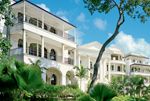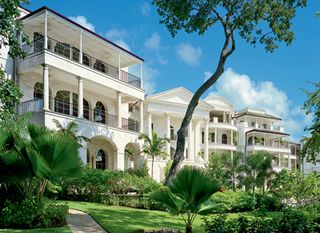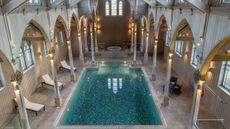Luxury villas for sale on Barbados
Barbados is hot again as buyers return to snap up upmarket heritage homes


After two years in the doldrums, when property prices in Barbados fell for the first time in 30 years in some cases by as much as 25%-the buzz has returned to this most English of Caribbean islands. All the hardy annuals are back in residence, and the best rental houses are full for the season. The bars and restaurants are doing a roaring trade, and the new chef at the Sandy Lane hotel has been hailed as a great success-although I hear the new manager of The Cliff in St James has jumped ship after only three weeks.
Rumours abound regarding the imminent revival of the stalled Four Seasons development (thanks to an injection of fresh funds and Government enthusiasm for the scheme), although no restart date has yet been announced. In the meantime, some of the project's original supporters have bought elsewhere on the island, notably Lord and Lady Lloyd Webber who are remodelling and extending a landmark villa on the Old Course at Sandy Lane.

Now that the dust has settled, leading agents on the island are sanguine about the recent reduction in the number of residential projects currently on stream, which has boosted the fortunes of longer-established developments such as Sandy Lane, Royal Westmoreland, Port St Charles and Sugar Hill. Historically, unlike most islands in the Caribbean, where sugar plantations were usually owned by absentee landlords, most plantation owners in Bar-bados were permanent residents.
The ‘sugar revolution' of the early 1600s created huge wealth for the estate owners, and, by the late 17th century, the island was reckoned to be the ‘richest spote of ground in the worlde'. It became the norm for plantation owners to build a splendid ‘great house' that served both as a family home and the focal point of the estate, and the Barbadian landscape was soon scattered with grand plantation houses, many of which have been restored and redeveloped as elegant heritage homes, under the benevolent gaze of the Barbados National Trust.
With hindsight, October 2008 was probably not the best time to launch a luxury house on the market anywhere in the world, although, at that point, prices in Barbados were still climbing by 15%-20% a year. But film-producer Paul Astrom-Andrews and his wife, Sarah-Jane, having rescued historic Bellevue plantation house in St Michael from a state of rack and ruin, are confident that the right buyer will be along soon at the current asking price of $3.5m through Knight Frank (020-7629 8171). ‘In the meantime, the house is rented out solidly between now and the middle of May. At $2,000 a day, the rental more than covers our out goings,' says Mr Astrom-Andrews, who has other property interests at Apes Hill, Barbados, and also in St Kitts and Antigua.
During their eight-year tenure, the couple has transformed the house from an 8,000sq ft wreck into a 12,000sq ft colonial mansion with a 2,000sq ft cottage and three acres of landscaped grounds. Built between 1735 and 1750, and believed to be the second oldest house in Barbados, the main house has eight bedrooms, expansive formal and informal dining areas and a vast patio overlooking the swimming pool and deck. The severity of the original Georgian exterior has been softened by a traditional wrap-around balcony, which allows guests to enjoy views of the surrounding countryside and the dramatic Barbadian sunsets.
London-based Caribbean Property (020-7622 6515), which acts as a UK clearing-house for upmarket agents throughout the Caribbean, recently added two more fine plantation houses to its Barbadian property portfolio. Originally built in the 1700s, illustrious Mangrove Plantation in St Peter lay in ruins when it was rescued in 2000. Now a beautifully restored family house set in 25 acres of glorious tropical gardens, it has four bedrooms, three bathrooms, a renovated coach house, a romantic, restored mill with a bar and viewing deck, and a guide price of $9.8m.
Sign up for the Country Life Newsletter
Exquisite houses, the beauty of Nature, and how to get the most from your life, straight to your inbox.
Even grander is the prestigious Lion Castle Plantation in St Thomas, a tranquil, 140-acre estate on the market at $11m. It has a four-bedroom, coral stone Great House, originally built in 1721, with 9,000sq ft of living space on three floors, a three-bedroom manager's house, and a two-storey apartment building, comprising a pair of two-bedroom staff apartments. Proof that the best will always sell-eventually-is the success of exclusive Westland Heights, which stands beside the Royal Westmoreland golf and country club.
Built between 2007 and 2009 by a group of successful local businessmen, it comprises nine splendid houses designed by international architects Italica Architetturra, each boasting some 7,000sq ft of living space and set in about an acre of land, of which four have already found buyers. Currently for sale through Cluttons Barbados (00 1 246 432 4663) at a guide price of $3.6m, palatial 1, Westland Heights has a three-bedroom main house, a two-bedroom cottage, a dining gazebo and an infinity-edge pool with breathtaking West Coast views.
Further proof of Barbados's historic ability to bounce back from the brink of disaster is the recent launch of The Sands at Sandy Lane (pictured), designed by Barbadian architect Larry Warren and backed by one of the owners of the iconic Sandy Lane hotel. Here, eight opulent villa-apartments are being offered to a select international clientele by local agents Altman Real Estate (00 1 246 432 0840) and Christie's International at starting prices of $35m and upwards. Not surprisingly, the reaction of the handful of potential purchasers who have seen the inside of this gilded enclave was a simple ‘Wow!', selling agent Paul Altman reveals.
Country Life is unlike any other magazine: the only glossy weekly on the newsstand and the only magazine that has been guest-edited by HRH The King not once, but twice. It is a celebration of modern rural life and all its diverse joys and pleasures — that was first published in Queen Victoria's Diamond Jubilee year. Our eclectic mixture of witty and informative content — from the most up-to-date property news and commentary and a coveted glimpse inside some of the UK's best houses and gardens, to gardening, the arts and interior design, written by experts in their field — still cannot be found in print or online, anywhere else.
-
 If heaven is on earth, it might be in this home with a converted chapel that is now a swimming pool
If heaven is on earth, it might be in this home with a converted chapel that is now a swimming pool5 Wood Barton Town House is part of an exclusive 80-acre development in Devon that also comes with fishing rights on the River Avon and four bedrooms.
By James Fisher Published
-
 An Italian-inspired recipe for lemon-butter pasta shells with spring greens, ricotta and pangrattato
An Italian-inspired recipe for lemon-butter pasta shells with spring greens, ricotta and pangrattatoSpring greens are just about to come into their own, so our Kitchen Garden columnist reveals exactly what to do with them.
By Melanie Johnson Published
